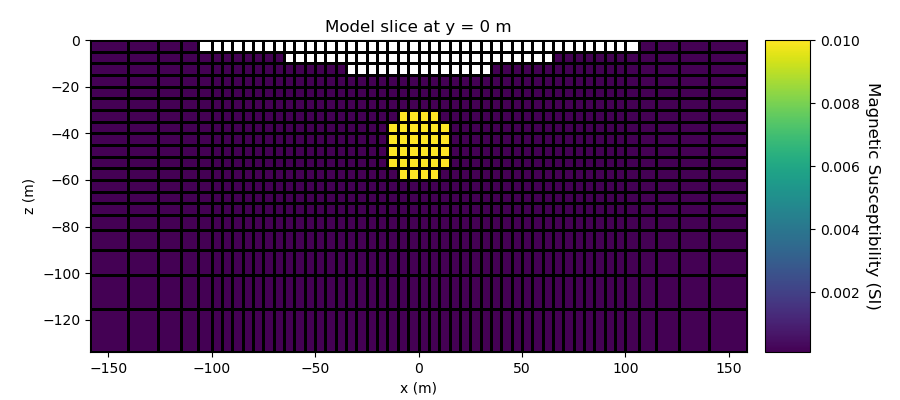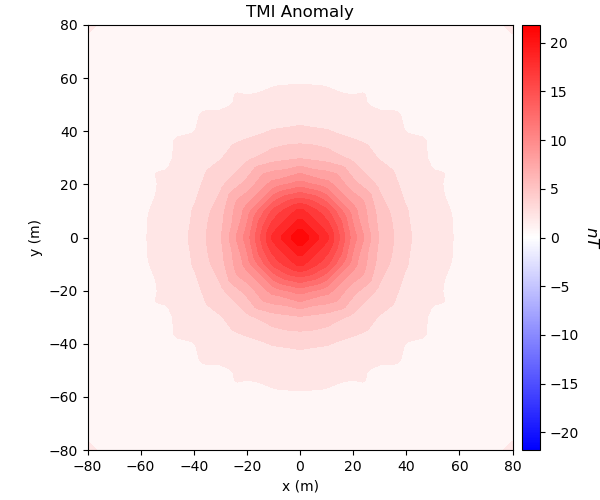Note
Go to the end to download the full example code
Forward Simulation of Total Magnetic Intensity Data#
Here we use the module SimPEG.potential_fields.magnetics to predict magnetic data for a magnetic susceptibility model. We simulate the data on a tensor mesh. For this tutorial, we focus on the following:
How to define the survey
How to predict magnetic data for a susceptibility model
How to include surface topography
The units of the physical property model and resulting data
Import Modules#
import numpy as np
from scipy.interpolate import LinearNDInterpolator
import matplotlib as mpl
import matplotlib.pyplot as plt
import os
from discretize import TensorMesh
from discretize.utils import mkvc, active_from_xyz
from SimPEG.utils import plot2Ddata, model_builder
from SimPEG import maps
from SimPEG.potential_fields import magnetics
write_output = False
# sphinx_gallery_thumbnail_number = 2
Topography#
Surface topography is defined as an (N, 3) numpy array. We create it here but topography could also be loaded from a file.
Defining the Survey#
Here, we define survey that will be used for the simulation. Magnetic surveys are simple to create. The user only needs an (N, 3) array to define the xyz locations of the observation locations, the list of field components which are to be modeled and the properties of the Earth’s field.
# Define the observation locations as an (N, 3) numpy array or load them.
x = np.linspace(-80.0, 80.0, 17)
y = np.linspace(-80.0, 80.0, 17)
x, y = np.meshgrid(x, y)
x, y = mkvc(x.T), mkvc(y.T)
fun_interp = LinearNDInterpolator(np.c_[x_topo, y_topo], z_topo)
z = fun_interp(np.c_[x, y]) + 10 # Flight height 10 m above surface.
receiver_locations = np.c_[x, y, z]
# Define the component(s) of the field we want to simulate as a list of strings.
# Here we simulation total magnetic intensity data.
components = ["tmi"]
# Use the observation locations and components to define the receivers. To
# simulate data, the receivers must be defined as a list.
receiver_list = magnetics.receivers.Point(receiver_locations, components=components)
receiver_list = [receiver_list]
# Define the inducing field H0 = (intensity [nT], inclination [deg], declination [deg])
inclination = 90
declination = 0
strength = 50000
inducing_field = (strength, inclination, declination)
source_field = magnetics.sources.SourceField(
receiver_list=receiver_list, parameters=inducing_field
)
# Define the survey
survey = magnetics.survey.Survey(source_field)
Defining a Tensor Mesh#
Here, we create the tensor mesh that will be used for the forward simulation.
Defining a Susceptibility Model#
Here, we create the model that will be used to predict magnetic data and the mapping from the model to the mesh. The model consists of a susceptible sphere in a less susceptible host.
# Define susceptibility values for each unit in SI
background_susceptibility = 0.0001
sphere_susceptibility = 0.01
# Find cells that are active in the forward modeling (cells below surface)
ind_active = active_from_xyz(mesh, xyz_topo)
# Define mapping from model to active cells
nC = int(ind_active.sum())
model_map = maps.IdentityMap(nP=nC) # model is a vlue for each active cell
# Define model. Models in SimPEG are vector arrays
model = background_susceptibility * np.ones(ind_active.sum())
ind_sphere = model_builder.getIndicesSphere(
np.r_[0.0, 0.0, -45.0], 15.0, mesh.cell_centers
)
ind_sphere = ind_sphere[ind_active]
model[ind_sphere] = sphere_susceptibility
# Plot Model
fig = plt.figure(figsize=(9, 4))
plotting_map = maps.InjectActiveCells(mesh, ind_active, np.nan)
ax1 = fig.add_axes([0.1, 0.12, 0.73, 0.78])
mesh.plot_slice(
plotting_map * model,
normal="Y",
ax=ax1,
ind=int(mesh.shape_cells[1] / 2),
grid=True,
clim=(np.min(model), np.max(model)),
)
ax1.set_title("Model slice at y = 0 m")
ax1.set_xlabel("x (m)")
ax1.set_ylabel("z (m)")
ax2 = fig.add_axes([0.85, 0.12, 0.05, 0.78])
norm = mpl.colors.Normalize(vmin=np.min(model), vmax=np.max(model))
cbar = mpl.colorbar.ColorbarBase(ax2, norm=norm, orientation="vertical")
cbar.set_label("Magnetic Susceptibility (SI)", rotation=270, labelpad=15, size=12)
plt.show()

Simulation: TMI Data for a Susceptibility Model#
Here we demonstrate how to predict magnetic data for a magnetic susceptibility model using the integral formulation.
# Define the forward simulation. By setting the 'store_sensitivities' keyword
# argument to "forward_only", we simulate the data without storing the sensitivities
simulation = magnetics.simulation.Simulation3DIntegral(
survey=survey,
mesh=mesh,
model_type="scalar",
chiMap=model_map,
ind_active=ind_active,
store_sensitivities="forward_only",
)
# Compute predicted data for a susceptibility model
dpred = simulation.dpred(model)
# Plot
fig = plt.figure(figsize=(6, 5))
v_max = np.max(np.abs(dpred))
ax1 = fig.add_axes([0.1, 0.1, 0.8, 0.85])
plot2Ddata(
receiver_list[0].locations,
dpred,
ax=ax1,
ncontour=30,
clim=(-v_max, v_max),
contourOpts={"cmap": "bwr"},
)
ax1.set_title("TMI Anomaly")
ax1.set_xlabel("x (m)")
ax1.set_ylabel("y (m)")
ax2 = fig.add_axes([0.87, 0.1, 0.03, 0.85])
norm = mpl.colors.Normalize(vmin=-np.max(np.abs(dpred)), vmax=np.max(np.abs(dpred)))
cbar = mpl.colorbar.ColorbarBase(
ax2, norm=norm, orientation="vertical", cmap=mpl.cm.bwr
)
cbar.set_label("$nT$", rotation=270, labelpad=15, size=12)
plt.show()

Optional: Export Data#
Write the data and topography
if write_output:
dir_path = os.path.dirname(__file__).split(os.path.sep)
dir_path.extend(["outputs"])
dir_path = os.path.sep.join(dir_path) + os.path.sep
if not os.path.exists(dir_path):
os.mkdir(dir_path)
fname = dir_path + "magnetics_topo.txt"
np.savetxt(fname, np.c_[xyz_topo], fmt="%.4e")
np.random.seed(211)
maximum_anomaly = np.max(np.abs(dpred))
noise = 0.02 * maximum_anomaly * np.random.rand(len(dpred))
fname = dir_path + "magnetics_data.obs"
np.savetxt(fname, np.c_[receiver_locations, dpred + noise], fmt="%.4e")
Total running time of the script: (0 minutes 6.692 seconds)
Estimated memory usage: 8 MB